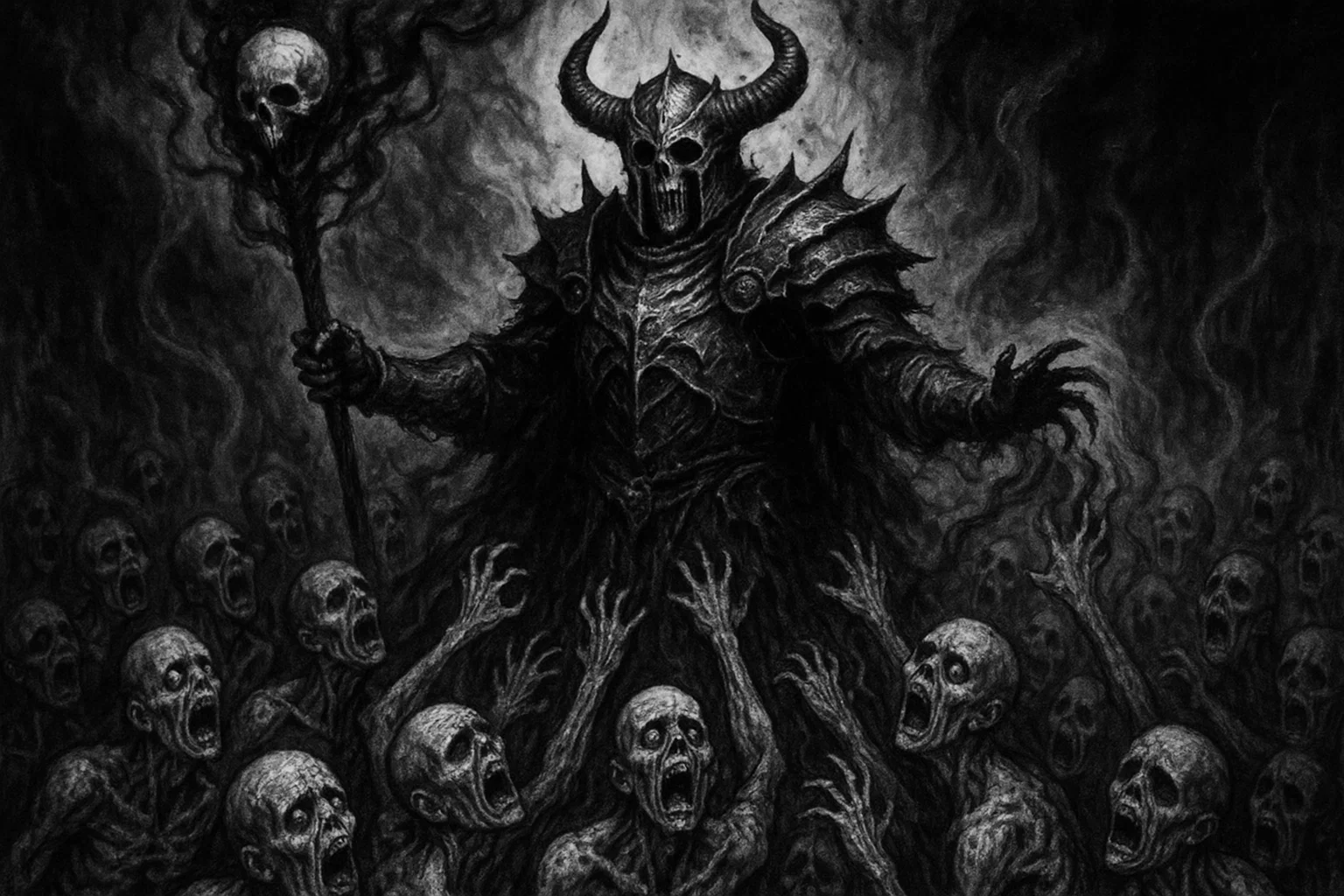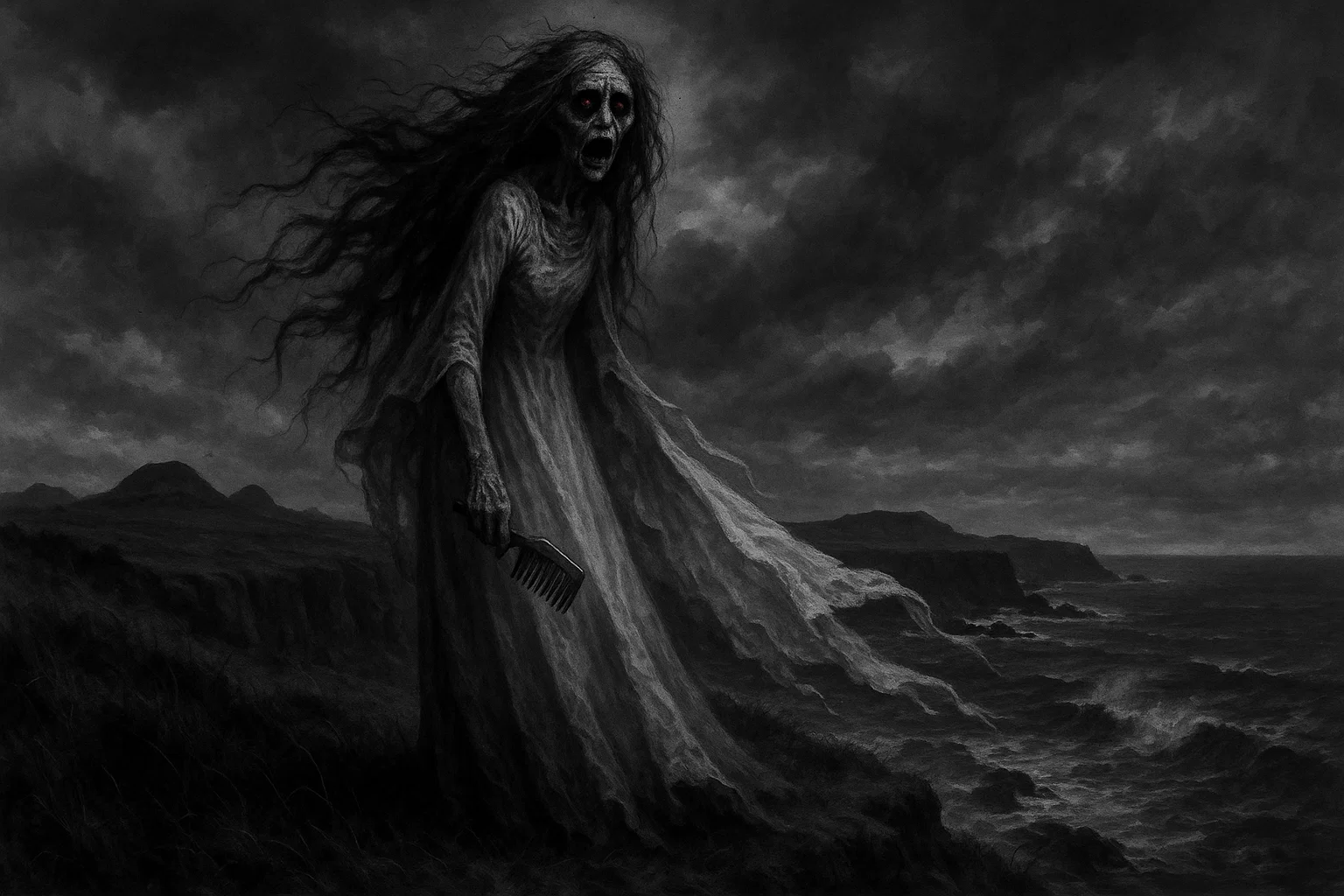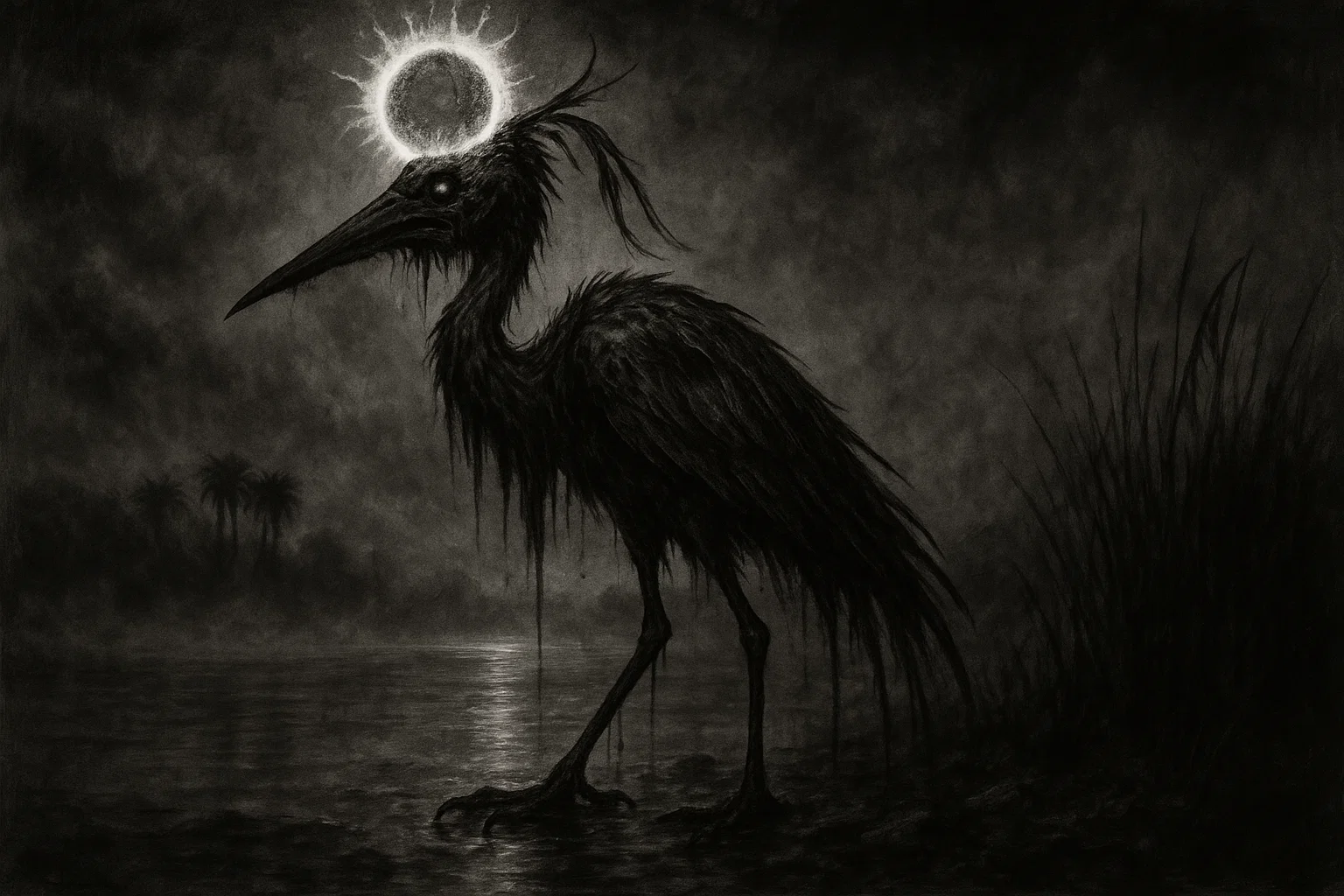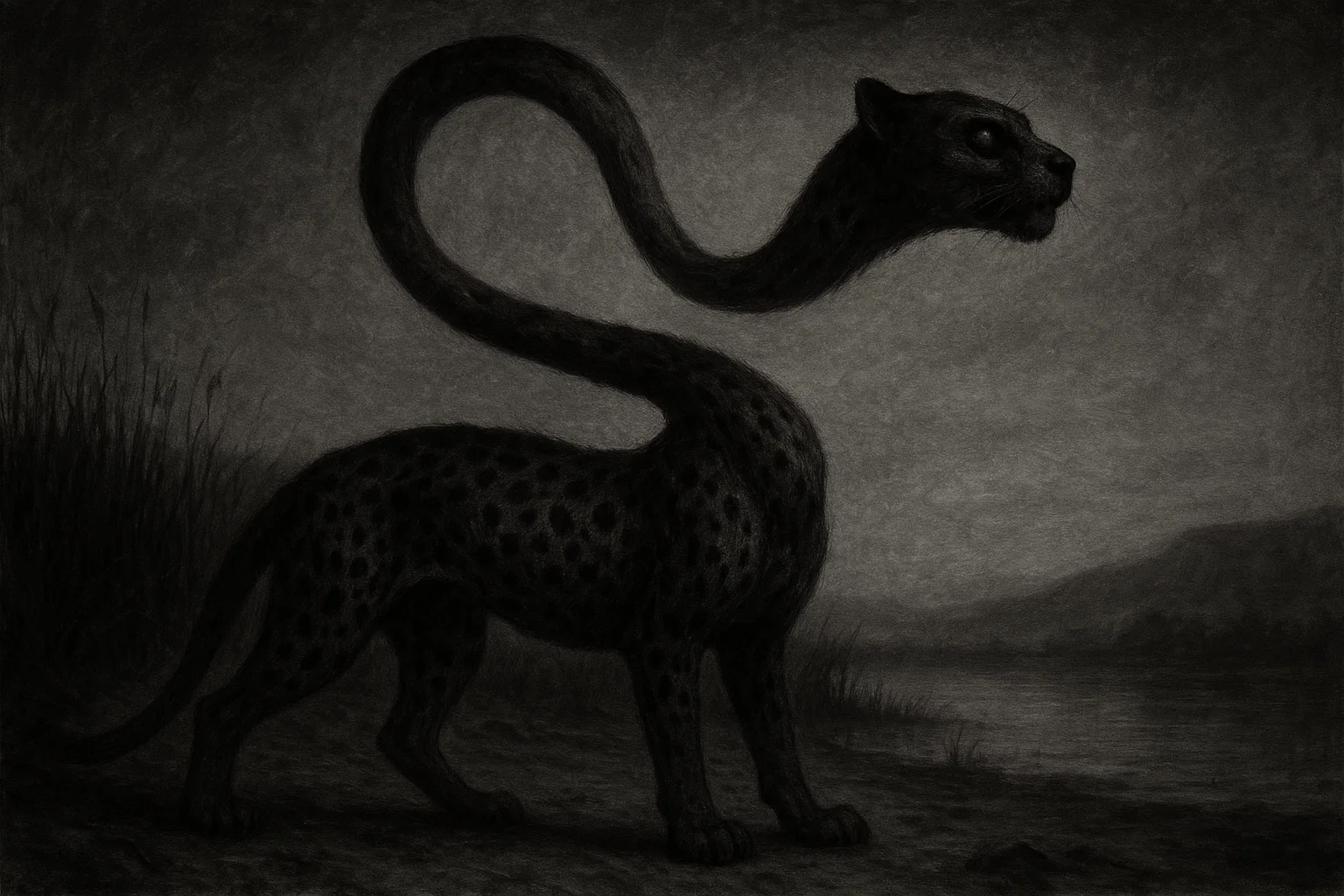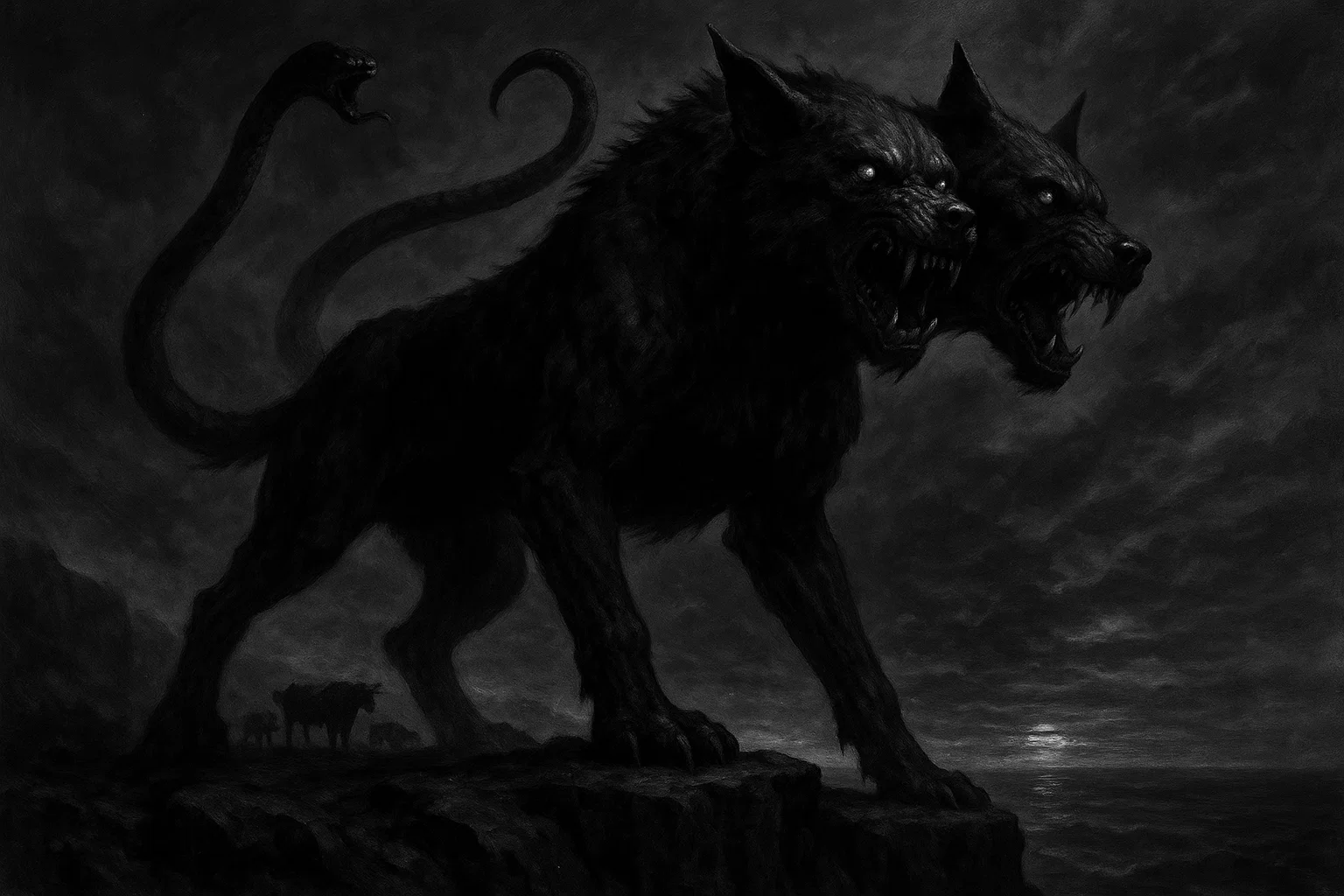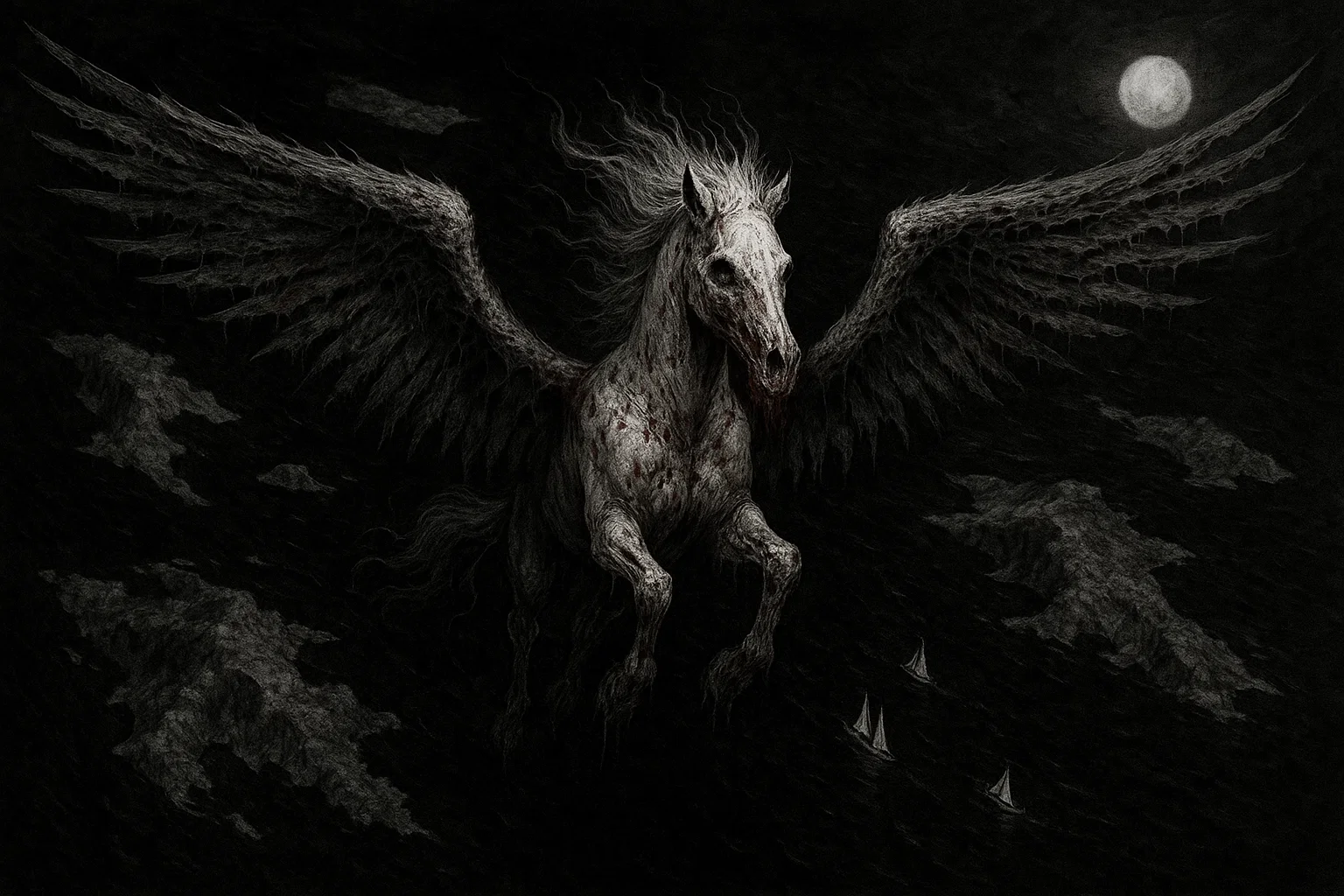Murmur, the 54th spirit of the Ars Goetia, lurks in the shadows of demonology. A master of necromancy and philosophy, this demon tempts mortals with forbidden knowledge. His eerie name resonates through ancient grimoires, tied to death’s whispers and occult secrets.
Summary
Key Information
This table compiles essential details about Murmur, the demon of necromantic arts:
| Attribute | Description |
|---|---|
| Name | Murmur, Murmus, Murmux, Murmuur, Mormo |
| Title | Great Duke, Earl of Hell |
| Gender | Male |
| Role | Master of necromancy, teacher of philosophy, conjurer of deceased souls |
| Hierarchy | 54th of 72 spirits in Ars Goetia, commands 30 legions |
| Servitors | Two trumpet-bearing ministers, spectral warriors, lesser imps |
| Superior Demon | Reports to Lucifer, possibly Beelzebub or Astaroth |
| Powers | Summons dead souls, teaches philosophy, manipulates spiritual energies, casts illusions |
| Appearance | Warrior in dark armor, rides vulture or griffin, wears ducal crown, preceded by trumpeters |
| Etymology | Latin murmur (whisper, low sound), Old French murmure (discontent) |
| Associated Figures | King Solomon, fallen angels, necromancers, occult scholars |
| Weaknesses | Bound by divine names (e.g., Tetragrammaton), precise rituals required |
| Opposing Angel/Saint | Nithael (angel of rejuvenation, speculative) |
| Equipment/Tools | Ducal crown, vulture/griffin mount, trumpets, necromantic sigils |
| Pantheon | Abrahamic demonology, Goetic tradition |
Etymology
The name Murmur originates from Latin murmur, meaning a soft, continuous sound, like a whisper, rustling leaves, or a distant trumpet blast.
In ancient Rome, murmur described natural sounds, such as a babbling brook or muttered complaints, suggesting secrecy and unease. Medieval Latin texts used murmur for supernatural noises, aligning with Murmur’s ghostly communications.
The Old French murmure, meaning discontent or grumbling, adds a layer of malevolence, implying he sows discord. Alternate names—Murmus, Murmux, Murmuur, and Mormo—reflect scribal variations across grimoires. Mormo, linked to a Greek spirit that frightened children, suggests a possible Hellenistic influence, tying Murmur to fear-inducing entities.
His name’s phonetic quality mirrors the eerie sounds of his trumpet-bearing ministers, reinforcing his sinister presence in occult lore.
In demonology, names hold power; Murmur’s title encapsulates his ability to manipulate the dead and corrupt the living with whispered temptations.
You May Also Like: The Adjule: Is the Sahara Hiding a Secret Predator?
What Does the Demon Murmur Look Like?
Murmur manifests as a grim warrior, clad in blackened, battle-scarred armor etched with occult runes. He rides a vulture, its tattered wings and piercing eyes exuding decay, or a griffin, a lion-eagle hybrid symbolizing dominion over earth and sky.
A ducal crown, ornate yet tarnished, rests on his head, marking his infernal rank. Two ministers, shrouded in spectral mist, precede him, blowing massive trumpets that emit haunting, resonant tones.
His eyes glow with a cold, otherworldly light, and his presence radiates malice. Some accounts depict him solely as a vulture, with sharp talons and a ragged beak, emphasizing his connection to death’s carrion.
Historical and Mythological Background
Murmur, the 54th spirit of the Ars Goetia within the Lesser Key of Solomon, emerges from a rich tapestry of demonological lore rooted in Jewish, Christian, and Hellenistic traditions.
This 17th-century grimoire, compiled around 1680 CE, draws heavily from earlier texts like the Testament of Solomon (circa 1st–5th century CE) and medieval occult works.
Murmur, a fallen angel from the celestial orders of Thrones (symbolizing divine judgment) and Angels (messengers of God), is said to have joined Lucifer’s rebellion against Heaven, choosing infernal power over divine servitude.
His primary role as a necromancer—summoning and controlling the souls of the deceased—ties him to ancient death cults and underworld deities across cultures, though direct connections remain speculative.
His mythology, while centered in Abrahamic demonology, suggests echoes of older pagan traditions, demonized to fit Christian narratives. Below, we explore Murmur’s origins and the specific myths, legends, and cultural parallels that define his sinister legacy.
Solomon’s Binding of Murmur
According to the Ars Goetia, King Solomon, ruling Israel around 970 BCE, bound Murmur to serve his divine mission of constructing the Temple of Jerusalem.
Endowed with wisdom by God, Solomon used a magical ring inscribed with the Tetragrammaton (YHWH, the sacred name of God) to command 72 demons, including Murmur. This demon’s necromantic skills were particularly valuable.
A legend from the Testament of Solomon implies Murmur was summoned to interrogate the souls of deceased sages, extracting knowledge about hidden treasures and divine secrets. One tale recounts Solomon invoking Murmur to summon the spirit of a Babylonian priest, who revealed the location of a sacred artifact buried beneath Jerusalem.
However, Murmur resisted, attempting to deceive Solomon with false visions. Only through precise rituals and divine names did Solomon subdue him, binding Murmur to a brass vessel with other demons.
The Theft of the Griffin
A lesser-known but evocative tale claims Murmur, before his fall from Heaven, stole a griffin from the Garden of Eden. This mythical creature, with a lion’s body and an eagle’s wings, symbolized divine harmony between earth and sky.
Murmur’s theft was an act of rebellion, transforming the griffin into a steed of war and decay. In one apocryphal story, set during the celestial war, Murmur rode this griffin against the archangel Michael, wielding a spear forged from infernal fire.
The griffin’s roars echoed across the heavens, sowing fear among angelic ranks. After his defeat, Murmur retained the griffin—or, in some accounts, a vulture—as his mount in Hell, using it to traverse the underworld’s desolate realms.
You May Also Like: The Dybbuk Box Mystery: What’s Inside the Cursed Box?
The Trumpets of the Damned
Medieval European folklore, particularly from 14th-century Bohemia, paints Murmur as a harbinger of death on battlefields. His two trumpet-bearing ministers, described as spectral figures cloaked in tattered robes, heralded his arrival with haunting blasts that woke the dead.
One chilling legend from Prague, circa 1350 CE, tells of a necromancer named Janek of Vyšehrad, who invoked Murmur to commune with fallen knights after a skirmish with Hussite rebels.
Murmur appeared, his trumpets shaking the earth, and summoned the knights’ souls, who revealed enemy plans. However, Murmur twisted their words, leading Janek to betray his allies, resulting in his execution.
The Wailing Vale
A 16th-century grimoire, the Liber Officiorum Spirituum (circa 1577 CE), describes Murmur ruling a shadowy underworld region called the Vale of Whispers. This desolate wasteland, filled with fog and echoing cries, serves as his necromantic domain.
Here, Murmur commands restless spirits, binding them to his will. A legend claims he once summoned the soul of a fallen crusader, Guillaume de Chartres (died 1219 CE), to torment a French bishop who opposed occult practices.
The bishop, plagued by visions of Guillaume’s accusing specter, descended into madness.
Connections to Ancient Deities
While Murmur is firmly rooted in Abrahamic demonology, his necromantic role and imagery suggest parallels with ancient deities, likely demonized by early Christian scribes.
In Mesopotamian mythology, Ereshkigal, queen of the underworld Irkalla, wielded authority over spirits, much like Murmur. Her dominion over the dead and association with dark rituals mirror his powers.
In Egyptian mythology, Osiris, god of the afterlife, judged souls in the underworld, a role akin to Murmur’s control over deceased spirits. His vulture mount evokes Nekhbet, an Egyptian goddess of death and protection, whose carrion imagery aligns with Murmur’s decay-laden aesthetic.
In Greek mythology, Hermes Psychopompos, the guide of souls to Hades, shares Murmur’s role as a mediator between worlds. The trumpet blasts heralding Murmur recall Triton, a Greek sea god who blew a conch to signal divine events.
The alternate name Mormo, linked to a Hellenistic bogeyman who terrified children, suggests a connection to Greek spirits of fear, possibly integrated into Christian demonology as a malevolent entity.
In Hindu tradition, Yama, the god of death, commands spirits and judges the dead, paralleling Murmur’s necromantic authority. Similarly, the Norse goddess Hel, ruler of the underworld, shares his grim dominion over spectral realms.
Medieval and Renaissance Context
During the Middle Ages, Murmur was a feared figure in Christian demonology. Clerics like Bernard of Clairvaux (1090–1153 CE) warned against necromantic practices, citing demons like Murmur as agents of Satan.
In the Renaissance, occultists such as Johannes Trithemius (1462–1516 CE) and Cornelius Agrippa (1486–1535 CE) referenced Murmur in their works, describing him as a teacher of forbidden arts.
His necromantic skills made him a target during the witch hunts of the 16th and 17th centuries. In 1587 CE, a German woman, Anna of Augsburg, was executed for allegedly summoning Murmur to commune with her deceased husband, an act deemed heretical.
You May Also Like: Curse of the Colonel Sanders: Coincidence or Real Haunting?
Historical Mentions
| Text/Grimoire | Description | Excerpt (Original) | English Translation |
|---|---|---|---|
| The Goetia: The Lesser Key of Solomon the King (translated by S.L. MacGregor Mathers) | 54th spirit, Great Duke and Earl, appears as a warrior on a griffin with a ducal crown, preceded by ministers with trumpets, teaches philosophy, constrains souls to appear | The Fifty-fourth Spirit is called Murmur, or Murmus, or Murmux. He is a Great Duke, and an Earl; and appeareth in the Form of a Warrior riding upon a Gryphon, with a Ducal Crown upon his Head. There do go before him those his Ministers, with great Trumpets sounding. His Office is to teach Philosophy perfectly, and to constrain Souls Deceased to come before the Exorcist to answer those questions which he may wish to put to them, if desired. He was partly of the Order of Thrones, and partly of that of Angels. He now ruleth 30 Legions of Spirits. And his Seal is this, which is to be worn as a Lamen before the Exorcist, etc. | (Original in English) |
| Pseudomonarchia Daemonum by Johann Weyer | Great Duke and Earl, appears as a soldier on a griffin with a duke’s crown, preceded by two ministers with great trumpets, teaches philosophy, constrains souls to appear | Murmur magnus Dux and Comes: Apparet militis forma, equitans in vulture, and ducali corona comptus. Hunc præcedunt duo ministri tubis magnis: Philosophiam absolute docet. Cogit animas coram exorcista apparere, ut interrogatæ respondeant ad ipsius quæsita. Fuit de ordine partim Thronorum, partim Angelorum. | Murmur, a great Duke and Earl: He appears in the form of a soldier, riding on a vulture, adorned with a ducal crown. Two ministers with great trumpets precede him. He teaches philosophy perfectly. He compels souls to appear before the exorcist to answer the questions posed to them. He was partly of the order of Thrones, partly of Angels. |
| Dictionnaire Infernal by Jacques Auguste Simon Collin de Plancy | Grand-duke and count of the infernal empire, demon of music, appears as a soldier on a vulture with a ducal crown, preceded by the noise of clarions, of the Order of Angels and Thrones | Murmur, grand-duc et comte de l’empire infernal, démon de la musique. Il paraît sous la forme d’un soldat monté sur un vautour et accompagné d’une multitude de trompettes ; sa tête est ceinte d’une couronne ducale ; il marche précédé du bruit des clairons. Il est de l’ordre des Anges et de celui des Trônes. | Murmur, grand-duke and count of the infernal empire, demon of music. He appears in the form of a soldier riding a vulture, accompanied by a multitude of trumpets; his head is adorned with a ducal crown; he advances preceded by the sound of clarions. He is of the order of Angels and of Thrones. |
Murmur’s Powers and Abilities
Murmur wields powers steeped in the grotesque and macabre, with necromancy as his most sinister art. This demon, a Great Duke and Earl of Hell, enslaves the souls of the deceased, twisting their essence to serve his malevolent will.
His abilities extend beyond mere communication with the dead, delving into horrific manipulation, spiritual torment, and forbidden knowledge.
Necromancy: Enslaving the Dead
Murmur’s necromancy is a chilling craft, allowing him to summon, bind, and enslave the souls of the deceased. Unlike benign spirit communication, his art is gruesome, forcing spirits into submission through infernal rituals.
He rips souls from their afterlife repose, dragging them into the mortal realm as wretched shades. These spirits, often depicted as decayed wraiths with hollow eyes and tattered forms, writhe in agony under his command.
Murmur compels them to answer questions, reveal secrets, or perform tasks, their spectral voices trembling with fear. For example, he might summon a fallen soldier’s soul, its ghostly flesh marked by wounds, to divulge battle strategies, or force a deceased scholar’s shade, dripping with ethereal rot, to recite forbidden texts.
The process is grotesque: spirits appear amidst a miasma of decay, their forms flickering like candle flames in a storm, bound by Murmur’s sigils etched in blood or ash.
His enslavement is not mere coercion but a violation of the soul’s sanctity. Murmur chains spirits to his will, using infernal enchantments that burn their essence, leaving them in perpetual torment.
Legends describe souls shrieking as they’re forced to obey, their spectral forms contorted into unnatural shapes—elongated limbs, gaping maws, or eyeless faces—to reflect their suffering.
In one tale, a 15th-century necromancer invoked Murmur to summon a merchant’s soul, only to witness the spirit’s form dissolve into a writhing mass of worms, a punishment for defying Murmur’s command. This macabre display ensures obedience, as the enslaved souls dread further desecration.
You May Also Like: Jinmenken: Japan’s Terrifying Human-Faced Dog
Forcing Souls to Serve
Murmur’s power to force souls into servitude is particularly horrifying. He bends spirits to perform grotesque tasks, from haunting the living to enacting his summoner’s dark desires.
For instance, he might command a soul to terrorize a village, appearing as a rotting corpse to spread fear and despair. These enslaved spirits, stripped of free will, are puppets in Murmur’s infernal theater, their actions twisted to sow chaos.
In a 16th-century German legend, Murmur forced the soul of a condemned thief to steal sacred relics from a church, the spirit’s hands oozing black ichor as it defiled the altar. Such acts corrupt both the soul and the summoner, as Murmur delights in perverting sacred bonds.
His control is maintained through necromantic sigils and chants, often requiring blood sacrifices or desecrated relics. These rituals are macabre, involving altars strewn with bones, candles made from human tallow, or chalices filled with grave dirt.
Murmur’s trumpeters, spectral ministers with hollowed faces, amplify his power, their blasts resonating with the screams of the damned, weakening spirits’ resistance.
The enslaved souls, bound to his will, suffer unending torment, their forms decaying further with each command, a grotesque reminder of Murmur’s dominion.
Temptation Through Forbidden Knowledge
Beyond necromancy, Murmur teaches philosophy, a term encompassing metaphysics, astrology, alchemy, and occult sciences in the Ars Goetia. This knowledge, while alluring, is a trap, laced with half-truths to corrupt the mind.
He whispers insights about the cosmos or afterlife, but these revelations drive scholars to obsession or madness. For example, he might reveal the structure of the infernal realms, only to implant visions of grotesque entities that haunt the learner’s dreams.
His philosophical teachings are delivered in a low, guttural murmur, evoking the sound of graves stirring, ensuring the listener’s soul is tainted by the forbidden.
Macabre Illusions and Psychic Torment
Murmur wields illusion-casting, creating horrific visions to deceive and terrify. He might conjure images of rotting corpses or spectral armies, their flesh peeling in grotesque layers, to break a summoner’s resolve.
These illusions are vivid, accompanied by the stench of decay or the sound of snapping bones, making them indistinguishable from reality. His psychic manipulation plants seeds of doubt, fear, or despair, often targeting the grieving.
In a modern horror tale, Murmur torments a widow by summoning her husband’s soul, its face a grotesque mask of worms, whispering lies that drive her to suicide.
Corrupting Through Necromantic Spectacles
Murmur’s necromancy is a tool of corruption, exploiting human curiosity and grief. Summoners seeking lost loved ones are met with grotesque parodies—souls with flayed skin or oozing wounds, forced to speak in Murmur’s voice.
These spectacles, designed to horrify, break the summoner’s spirit, binding them to Murmur’s will. His rituals often require macabre components, like the heart of a traitor or a child’s bone, ensuring the summoner’s moral decay.
By enslaving souls and staging these horrific displays, Murmur lures mortals into eternal damnation, his necromantic powers a grotesque gateway to infernal servitude.
You May Also Like: The Samurai’s Curse: A Horror Story of Vengeance
Murmur’s Role in the Hierarchy of Hell
Murmur holds the dual titles of Great Duke and Earl, commanding 30 legions—approximately 150,000–180,000 lesser demons. In hell’s hierarchy, he ranks below Kings (e.g., Bael, Paimon) and Princes (e.g., Beelzebub, Astaroth), reporting likely to Lucifer or Beelzebub.
His domain, a desolate underworld realm called the Vale of Whispers, is a misty wasteland where restless spirits linger. His armies include spectral warriors, ghostly soldiers bound to his will, and imps, minor demons who scout for souls. His trumpet-bearing ministers, possibly named Zephon and Camael (speculative), lead his forces.
Allies include Dantalion, who shares his knowledge-based powers, and Astaroth, a fellow philosopher-demon. Adversaries include Paimon, whose superior rank sparks rivalry, and Asmodeus, whose lust-driven agenda conflicts with Murmur’s cerebral malice.
Murmur’s interactions are strategic, using his necromantic skills to barter favors. His isolation in the Vale of Whispers reflects his focus on the dead, distancing him from hell’s more chaotic factions.
Astrological Associations and Symbolism
Murmur’s astrological ties enhance his mystique. Mercury, the planet of communication and intellect, governs his necromantic and philosophical roles.
The Air element aligns with his trumpet imagery and ethereal powers. Some link him to Sagittarius (November 22–December 21), tied to wisdom and exploration, especially for those born December 10–14.
His vulture/griffin mount symbolizes death and rebirth, reflecting his necromantic dominion. Associated metals are mercury (fluidity, transformation) and silver (mysticism, lunar energy).
Crystals include obsidian (protection, grounding), amethyst (spiritual insight), and jet (warding off evil). Colors are black (death, mystery), purple (royalty, occult power), and grey (neutrality, spirits). His number, 54, ties to his Goetic rank, symbolizing order within chaos.
Murmur’s Sigil
Murmur’s sigil, a complex geometric design, is etched in copper, the metal for Dukes, to summon him. Worn as a lamen, it channels his necromantic energy.
The sigil’s intricate lines resemble spiraling whispers, symbolizing his control over spirits. Summoners must use divine names like Tetragrammaton or Adonai to bind him, as Murmur exploits ritual errors to deceive or harm.
You May Also Like: The Village of Starving Souls | Horror Story
Comparison with Other Demons
| Demon | Rank | Appearance | Associated Symbols | Notable Characteristics |
|---|---|---|---|---|
| Bael | King | Three-headed figure: toad, man, and cat heads, speaking in a hoarse voice | Sun, gold, scepter, crown | Supreme ruler, commands vast legions, tied to solar power and deception, manipulative leader |
| Agares | Duke | Elderly man riding a crocodile, holding a goshawk, with a commanding presence | Mercury, emerald, hawk | Agile and destructive, specializes in chaos and communication, often undermines authority |
| Vassago | President | Serpent-like form, sometimes a gentle man with glowing eyes | Moon, silver, owl | Benevolent facade masks cunning, excels in divination, less aggressive than other demons |
| Samigina | Marquis | Small horse or ass, sometimes a humanoid scholar with a mournful expression | Venus, sapphire, dove | Focuses on intellectual pursuits, linked to water-related deaths, somber and scholarly |
| Marbas | President | Lion-headed man, occasionally a roaring lion with fiery eyes | Mars, iron, lion | Dual nature (healer/destroyer), practical knowledge, physically imposing, volatile temper |
| Valefor | Duke | Lion with a griffin’s head, sharp claws, and a cunning gaze | Mercury, topaz, griffin | Deceptive ally, promotes loyalty but tempts toward crime, smaller legion limits influence |
| Amon | Marquis | Wolf with a serpent’s tail, vomiting flames, sometimes a man with a raven’s head | Moon, amethyst, wolf | Emotionally manipulative, tied to lunar cycles, fierce yet persuasive, commands large forces |
| Barbatos | Duke | Archer with a viper’s head, clad in green, accompanied by four spectral kings | Jupiter, turquoise, bow | Harmonious with nature, scholarly but dangerous, commands respect among demons |
| Paimon | King | Man with a woman’s face, riding a dromedary, preceded by a cacophonous band | Sun, gold, crown, dromedary | Dominant and regal, vast knowledge, demands loyalty, most powerful among listed demons |
| Beleth | King | Fiery king on a pale horse, surrounded by trumpeters, exuding terror | Venus, ruby, rose | Terrifying yet seductive, specializes in emotional control, requires precise rituals |
Conclusion
Murmur, the Great Duke and Earl of Hell, embodies the peril of forbidden knowledge. His necromantic powers and philosophical teachings lure mortals into darkness, exploiting their curiosity and grief. From ancient grimoires to modern tales, his legacy warns of the dangers of dabbling in the occult.

